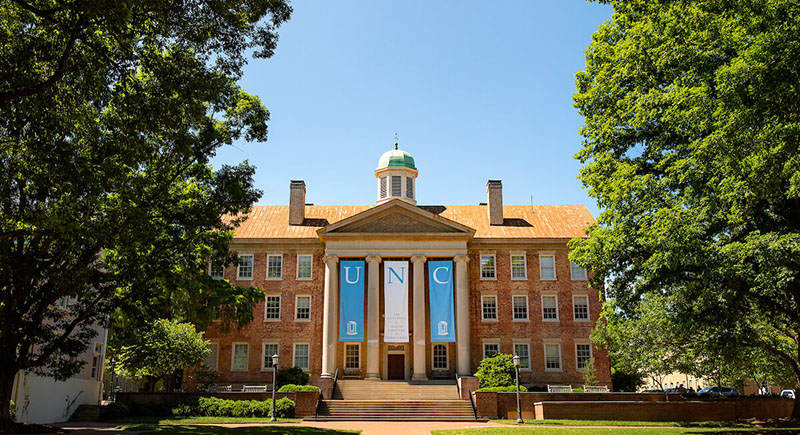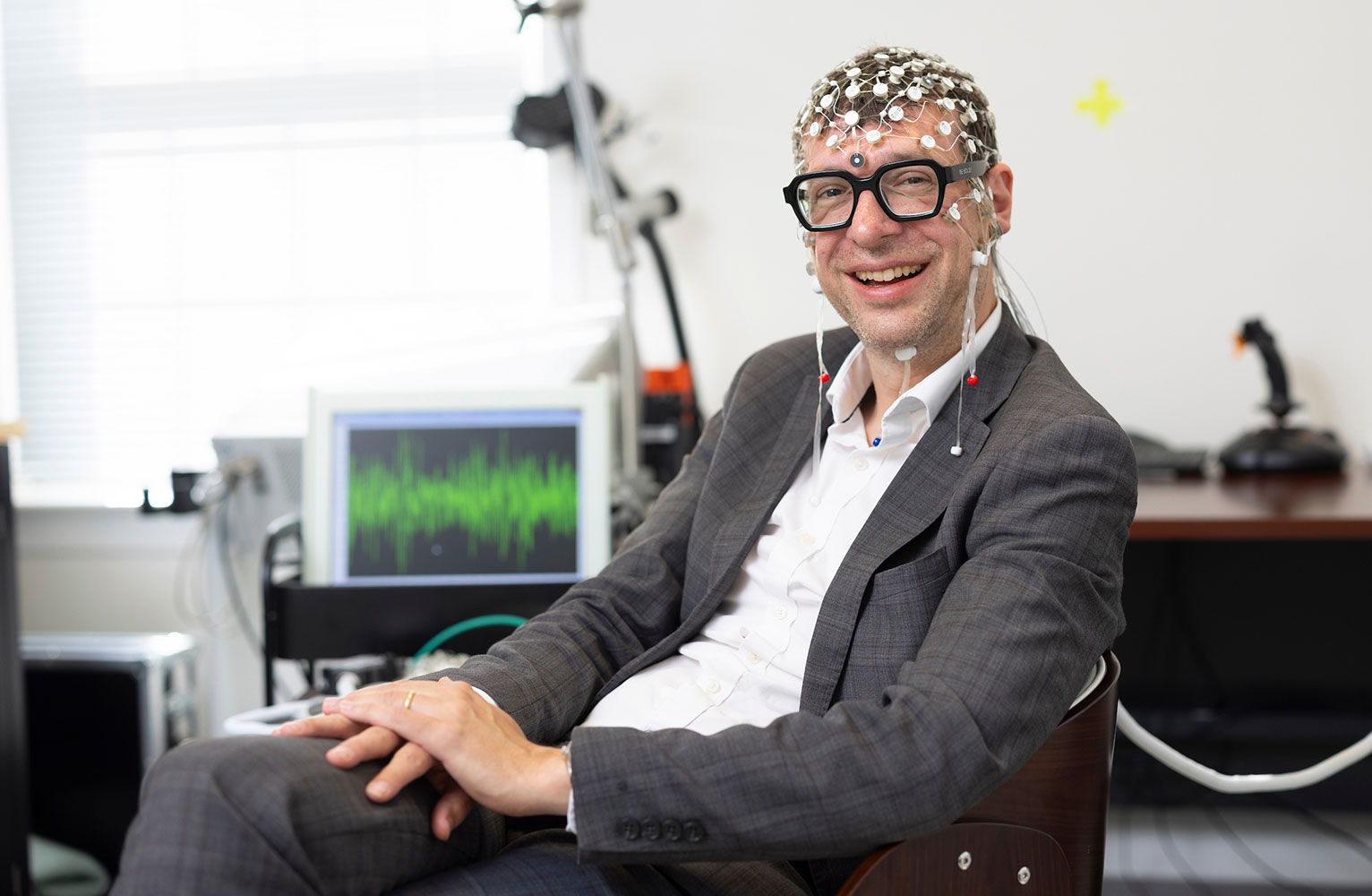
The research led by primary investigators Adam Hantman (right) and Ian Shih (left) has the potential to improve outcomes for people with brain damage. From left: Ian Shih, Scott Tyler Albert, Sheng Song and Adam Hantman
Innovations in neuroscience with groundbreaking potential
Written by Simon Reeve-Parker
Photos by Jeyhoun Allebaugh
Imagine a river meandering through a valley, over time cutting a path through the softer ground and winding around the rockier places. One day a landslide produces a huge rockfall, damming the river. The once mighty river can no longer follow the course carved out over the ages.
What does this short hydrological hypothetical have to do with research into how impaired brains can heal?
Bypassing damaged circuitry
In the example above, water will begin to trickle through and over the rockfall, but only as a shadow of its former self. When the brain suffers damage, such as during a stroke, recovery can be slowed if the brain becomes trapped in a cycle of trying to use and repair the damaged circuit.
Alternatively, the brain can switch to undamaged neural tissue, which may allow for a more complete and successful recovery. Back in the valley, engineers could carve out a channel that bypasses the rockfall and allows the river to once again flow and rejoin its course.
How does the brain figure out a way around problems like this? What kind of signal forces it to select a more effective option? Where does this signal originate? And can it be used to improve outcomes for those with damage to the brain?
Funding the research
UNC-Chapel Hill faculty members Adam Hantman and Ian Shih, along with John Krakauer from Johns Hopkins University, are working to answer these questions thanks to a recently awarded $1.3 million grant from the W. M. Keck Foundation.
For 70 years, the W. M. Keck Foundation has funded pioneering research in the sciences and medicine. Their mission statement explains that “by funding the work of leading researchers, we are laying the groundwork for breakthrough discoveries and new technologies that will save lives [and] provide innovative solutions to complex problems.”
Hantman acknowledges that although the potential for breakthrough discoveries is significant, the uncertainties and scope of the project made securing traditional funding a challenge. UNC-Chapel Hill provided invaluable resources to get things moving, but the W. M. Keck Foundation’s grant, he noted, “offers us a runway to fully explore this idea, even though we’re starting from a pretty basic position.”
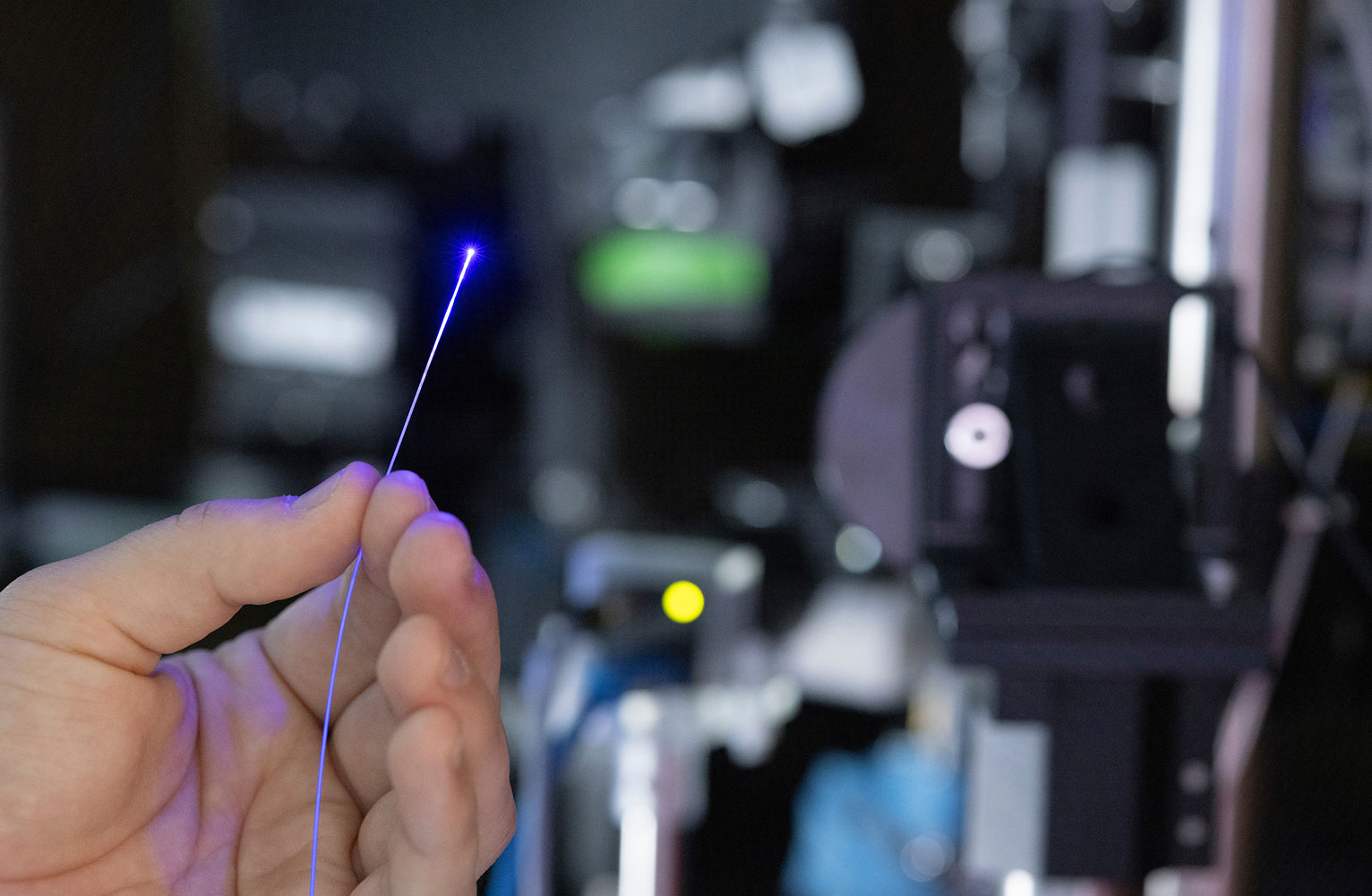
Hantman and his team have used a noninvasive technique on mice, known as optogenetics, that involves focusing a tiny beam of light on one part of the cerebral cortex that temporarily shuts it down.
An extraordinary discovery
It was a surprising find that became the catalyst for this project.
For many years, Hantman has worked to more fully understand the role of a part of the brain — the cerebral cortex — in fine motor control. He and his team have used a noninvasive technique on mice, known as optogenetics, that involves focusing a tiny beam of light on one part of the cerebral cortex that temporarily shuts it down.
The mice have been trained to reach and grab food pellets, but when the light shines on their brains, they can’t perform the necessary movements. When the light shuts off, they can go back to snacking.
This result was in line with expectations. But two findings proved extraordinary: First, some mice began to be able to reach and grab even while the light remained shining, meaning that the part of the brain controlling movement was completely shut down. Second, and paradoxically, when the level of impairment in these same mice was dialed back from 100% to, say, 80%, they were no longer able to reach and grab as effectively.
Finding innovative solutions to research problems
Seeing the mice performing these movements even while fully impaired, Hantman and his team knew that another part of the brain must be taking over that function.
The challenge? Finding which part.
Using a standard tool like electrodes to measure brain activity was not a viable option. As Scott T. Albert, a postdoctoral fellow and project member, explained, “Brains are huge and electrodes can only analyze one tiny part at a time. Poking around from place to place would take years upon years.”
A more promising technique is magnetic resonance imaging (MRI), which can provide a scan of the whole brain to look for activity in specific areas.
But, as anyone who has ever had an MRI can attest, there are two major issues: It is incredibly loud, and you have to remain completely still. Not only does the head have to be immobilized for an MRI of the brain, even moving an arm or leg can distort the magnetic field and the subsequent images.
To provide scans of the brains of mice while they are reaching for food pellets, these limitations become highly problematic. This is where the expertise of Ian Shih has proved essential. An innovation in imaging called SORDINO fMRI, developed by Shih’s lab with assistance from an National Institutes of Health grant awarded in 2023, will help the team to move forward.
This type of MRI is almost completely silent and resistant to distortions caused by movement. Using it will allow the team to scan mice while they perform the actions that were initially so surprising and hopefully show which parts of the brain are picking up the slack.
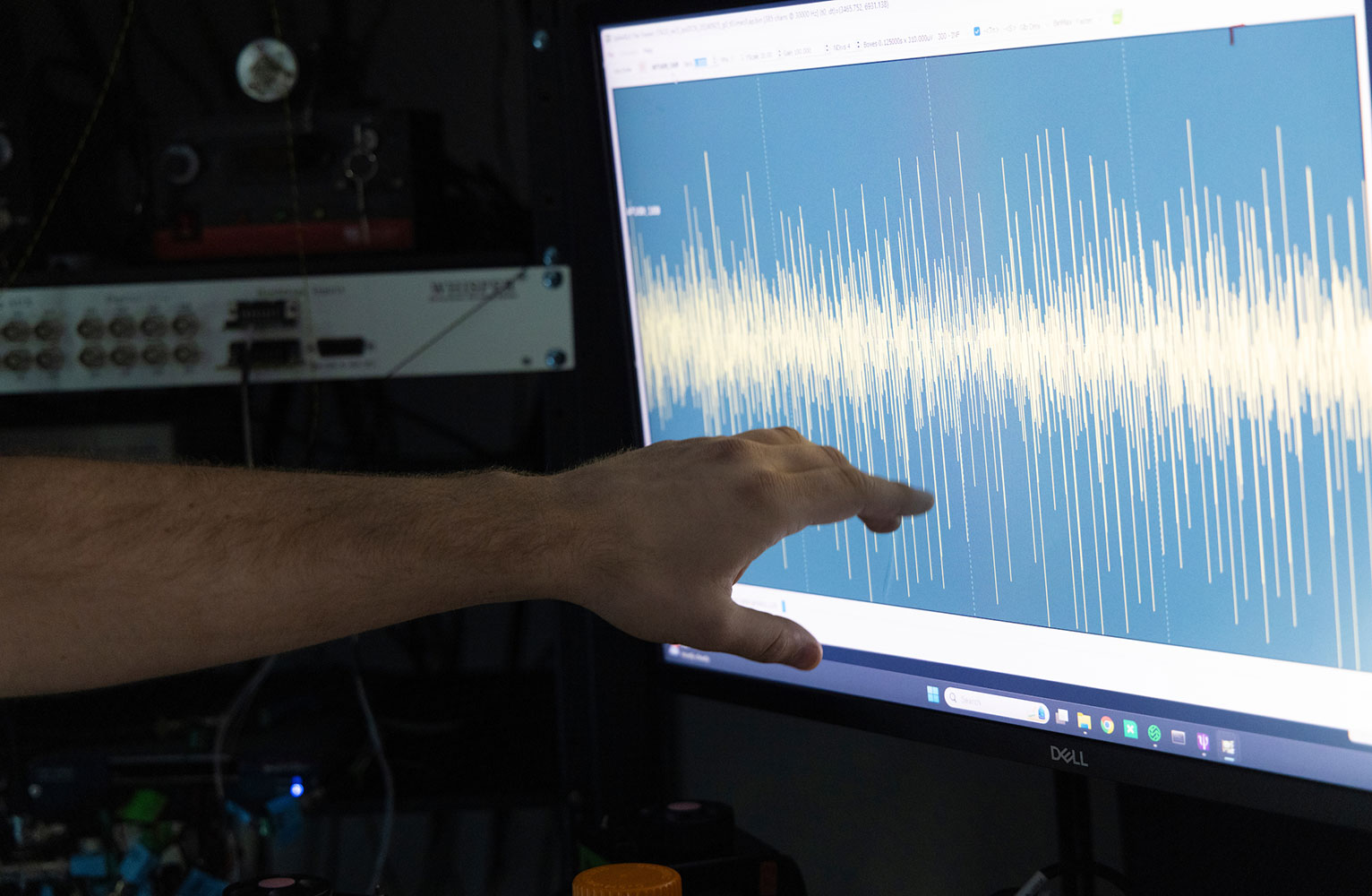
An innovation in imaging called SORDINO fMRI, developed by Shih’s lab with assistance from an National Institutes of Health grant awarded in 2023, will help the team to move forward.
Basic science and seeking answers
The scientific community sometimes differentiates between basic and applied science; basic in this sense meaning getting to the fundamentals or underlying processes of something. This project is a prime example of that: developing tools to try to answer key questions about what happens in the brain when it suffers damage and tries to recover.
To revisit the analogy of the blocked river, it’s clear that having engineers create a new, controlled channel could effectively bypass the rockfall and restore the river. But how do the engineers find out about the problem in the first place?
John W. Krakauer, one of the principal investigators and a renowned expert in stroke recovery, notes that a huge amount of research has already been done in this area, but without really finding the answers that have been sought.
With new tools at hand and by asking the questions differently, Krakauer added, “This is a chance to ask a lot of seemingly simple, basic, fundamental questions and revisit them in a kind of 2.0 version.”
Cautious optimism for pioneering applications
It is the nature of scientists, and an intrinsic part of the scientific method, to test a hypothesis rigorously while considering potential complications or alternative explanations. Basically, looking at as many of the “what ifs” as possible.
For example, the kind of temporary, reversible damage done to a mouse’s brain in this study is not the same as the damage that results from a stroke. In turn, stroke impacts are different again from those caused by a traumatic brain injury.
There is also the fact that mouse physiology is significantly different from that of a human or even other primates. Will findings from a study on mice also be applicable to a species (us) that last shared a common ancestor with them some 90 million years ago?
By developing tools and a study protocol to examine the very fundamentals — the whats, hows, wheres and whys of the switch in the brain that triggers a move to undamaged circuitry — the researchers are hopeful of a high level of applicability to human stroke recovery. Even though the type of damage may be different, they anticipate important similarities in the brain’s response.
As Krakauer explained, “the hope is that the basic science you’ve unearthed will give you an idea as to what to do to make people better.”
The project is still at an early stage, but Hantman, Shih and Krakauer believe it has the potential to yield important findings in stroke recovery by better discerning the underlying mechanisms in the brain.
Dr. David Hwang, a physician and professor in the UNC-Chapel Hill neurology department who is not involved with the project, agreed, noting that clinicians are often asked by patients and their families how brain function recovers after a stroke. Much about the process is not yet understood, which leads to limited interventions to improve recovery.
“The knowledge from this project could lead to new treatment approaches down the road for improving stroke recovery,” he said.
Noting especially the paradox of higher levels of impairment leading to better recovery outcomes, he added, “one could imagine therapies for human stroke patients in the future where perhaps specific areas in their brains affected by stroke are actually further deactivated using non-invasive tools — in order to encourage their brains to utilize their other healthy areas to improve overall neurologic function.”
By overcoming practical challenges and creating an innovative approach, and with the critical support of the W. M. Keck Foundation’s grant, the researchers hope to make real progress in the field as they gain new insights into fundamental communication between different regions of the brain.
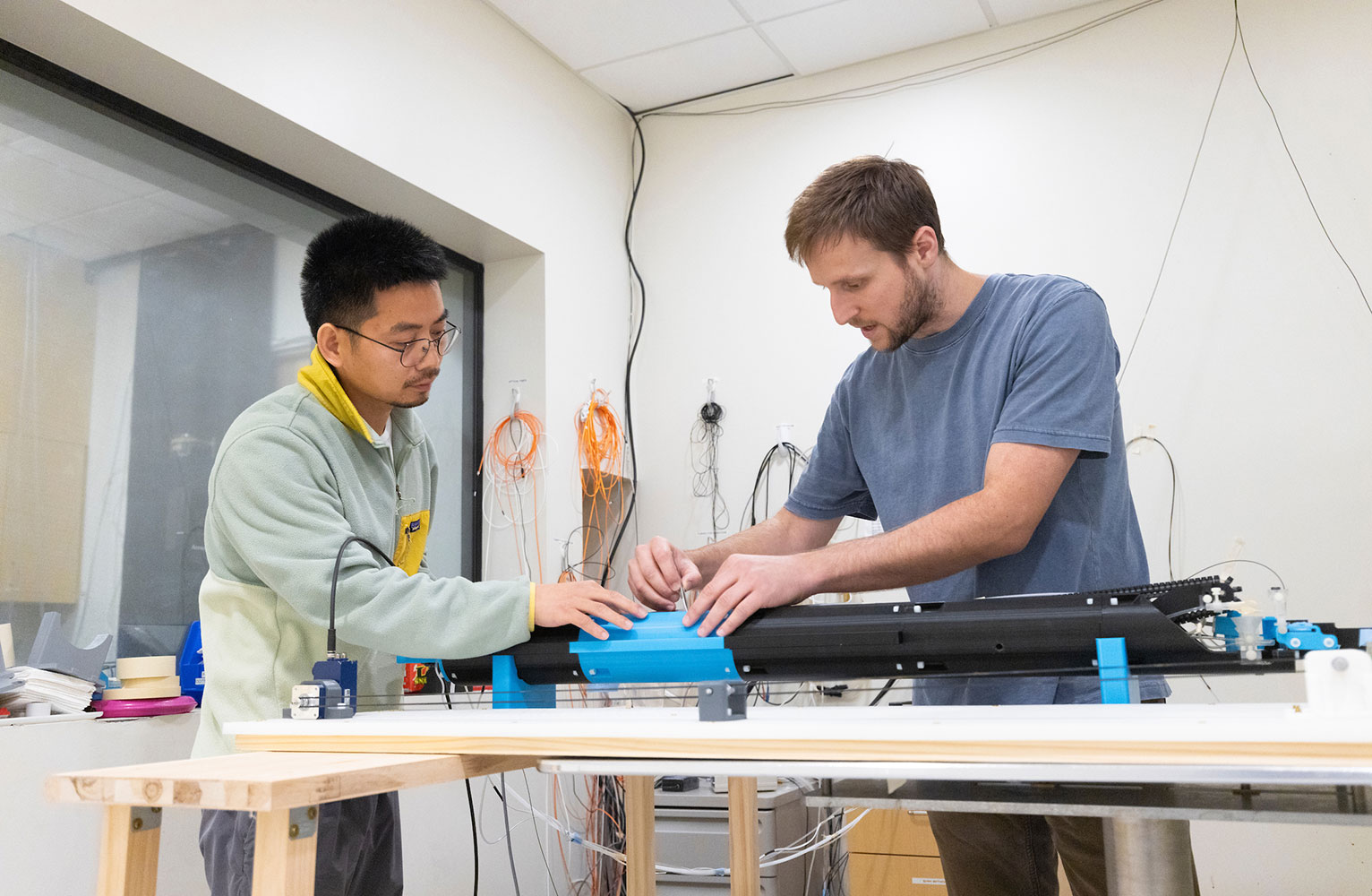
Neuroscientists Sheng Song (left) and Scott Tyler Albert work on a device that uses an MRI machine to image the brains of mice.
About the primary investigators
- Adam Hantman is an associate professor in the UNC School of Medicine’s Department of Cell Biology and Physiology, the Edward R. Perl Investigator and a member of the UNC Neuroscience Center.
- Ian Shih is professor and vice chair for research in the UNC School of Medicine’s Department of Neurology; director of the Center for Animal MRI; and associate director of the Biomedical Research Imaging Center.
- John Krakauer is a professor of neurology, neuroscience and physical medicine and rehabilitation at Johns Hopkins University.
About the W. M. Keck Foundation
Based in Los Angeles, the W. M. Keck Foundation was established in 1954 by the late W. M. Keck, founder of the Superior Oil Company. The Foundation’s grant making is focused primarily on pioneering efforts in the areas of medical research and science and engineering. The Foundation also supports undergraduate education and maintains a Southern California Grant Program that provides support for the Los Angeles community, with a special emphasis on children and youth. For more information, visit wmkeck.org.
Related Stories
